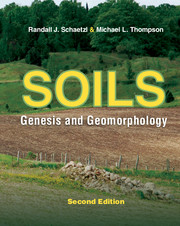15 - Soil Development and Surface Exposure Dating
Published online by Cambridge University Press: 12 January 2024
Summary
Basic Principles and Concepts
The age of a soil, sediment, surface, or geomorphic feature can inform us about the (1) period of initiation (timezero) of the soil or surface, (2) time interval over which the soil or surface has developed, and (3) geomorphic and pedogenic processes that have operated during that interval. Establishing the age of features, soils, or sediments is a key component of soil geomorphology. Various dating techniques are now at our disposal. These are continually being refined, and more methods are always being developed.
Because so many soil geomorphology studies now employ some type of dating, we stress the point made by Colman et al. (1987) when they argued for consistency in terminology among those using dating techniques. For example, a date (as a noun) is a specific point in time, e.g., AD 530 or July 14, 2013. An age is an interval of time measured back from the present, e.g., 11.7 ka. Colman et al. (1987) argued that the use of date should generally be minimized, in favor of age or age estimate. The terms ka and Ma are to be used for ages (thousands and millions of years as measured from the present, respectively) (Table 15.1). In addition, only radiocarbon ages should be expressed in terms of years before present (yr. BP) (Colman et al. 1987). All others should be calibrated to calendar years (see later discussion). For example, all other types of ages, including numerical and calibrated ages, should be referred to as ka or k.y., and so forth.
Ages can be determined for surfaces and for bodies of sediment. A chronostratigraphic unit is a body of rock that was formed during a specified interval of geologic time. It serves as the material reference for all rocks formed during the same span of time, and its boundaries are synchronous. A geochronometric unit is a division of time, based on the rock record. It corresponds to the time span of an established chronostratigraphic unit. A chronostratigraphic unit is bounded by synchronous horizons, i.e., its beginning and end coincide with the base and top of the referent chronostratigraphic unit. Types of geochronometric units include eons, eras, periods, epochs, and ages.
Of special importance to us is the pedostratigraphic unit – a body of rock or sediment that consists of one (or more) pedogenic horizon(s) that is overlain by one or more formally defined stratigraphic units.
- Type
- Chapter
- Information
- SoilsGenesis and Geomorphology, pp. 526 - 604Publisher: Cambridge University PressPrint publication year: 2015

